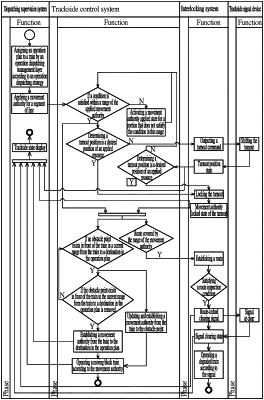| CPC B61L 27/70 (2022.01) [B61L 27/20 (2022.01); B61L 27/30 (2022.01); B61L 2027/204 (2022.01)] | 8 Claims |

|
1. An implementation method for an independent multimode train control system based on a trackside platform, wherein a trackside train control system and an interlocking system are provided independently in the method to meet requirements of a hybrid operation of trains having different systems; and at the same time, during an operation of a train in a moving block mode, once a trackside control system fails or a train on-board system fails, the multimode train control system can ensure that the train is degraded automatically and operates according to a degraded mode,
wherein the implementation method comprises: a process of establishing a movement authority; a process of releasing the movement authority; and a process of manually releasing the movement authority,
wherein the process of establishing the movement authority specifically comprises:
a1) applying a movement authority for a train by the dispatching supervision system according to an operation plan, and sending a movement authority applying for a current portion of line to the trackside control system;
a2) in case of the movement authority applied for the train, checking, by the trackside control system, whether a movement authority condition is satisfied within a range of the applied movement authority, if the movement authority condition is satisfied with respect to all or a portion of the line for which the movement authority is applied, checking whether the current portion of line for which the movement authority is applied includes a turnout, and if the movement authority condition is not satisfied with respect to all regions or a portion of the line within the range of the applied movement authority, activating, by the trackside control system, a movement authority applied state for all or a portion of the line that does not satisfy the condition, and continuously checking the movement authority condition within the line;
a3) if the movement authority condition is satisfied with respect to all or a portion of the line for which the movement authority is applied and the current portion of the line includes a turnout, checking and determining, by the trackside control system, whether a turnout position is a desired position of the movement authority applied, if not, outputting a turnout operating command to the interlocking system, which in turn outputs, upon receipt, the turnout operating command to a trackside turnout switch machine, acquires a turnout position state from a trackside signal device in real time, and sends the turnout position state to the dispatching supervision system, and if so, sending, by the trackside control system, an indication of locking all turnouts in the portion of line to the interlocking system, which in turn sends a turnout locked state to the dispatching supervision system;
a4) if the movement authority condition is satisfied with respect to all or a portion of the line for which the movement authority is applied, checking, by the trackside control system, whether an obstacle point exists in front of the train within a destination line range in a current train operation plan, regardless of whether the turnout is included within the range of the line;
a5) if the trackside control system checks an obstacle point existing in front of the train within the destination line range in the current train operation plan, detecting, in real time, whether the front obstacle point is cleared, and updating and establishing the movement authority from the train to the obstacle point;
a6) after the interlocking system locks the turnout, activating, by the interlocking system, a turnout movement authority locked state, which can be unlocked only by the trackside control system, checking, by the trackside control system, whether a train route in the same direction as the movement authority is included within the range of the movement authority, if so, sending a route establishment command to the interlocking system, checking, by the interlocking system, whether a route condition is satisfied, if satisfied, locking a route and clearing a signal, and if not satisfied, maintaining a current state of the route;
a7) if the trackside control system checks that an obstacle point in front of the train within the destination line range in the current train operation plan is removed, establishing a movement authority from the train to the destination of the operation plan, and sending a movement authority state to the dispatching supervision system;
a8) operating the train in the moving block mode to the end point of the currently established movement authority according to the range of the movement authority;
a9) if the interlocking system determines that the route is locked, outputting a signal clearing command to a trackside signal machine, which sends, after receiving a signal cleared state, the signal cleared state to the dispatching supervision system; and
a10), operating the train in the degraded mode according to the clearing signal and according to signal display.
|